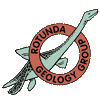Wykeham Quarry
Wykeham Quarry, situated adjacent to Rushton Lane (SE 959845), is currently used by a gun club as a shooting range. This large quarry has faces totalling about 350m in length and from 10-15m high. The sequence exposed lies entirely within the Coralline Oolite Formation (Lower to Middle Oxfordian) and shows admirably the boundary between the Hambleton Oolite and the overlying Middle Calcareous Grit. The Hambleton Oolite contains a persistent thin parting of bentonite clay. Below this clay parting it is richly fossiliferous with Pseudomelania heddingtonensis, Nanogyra sp., Chlamys fibrosa, Gervillella acuta, Camptonectes sp. and Aspidoceras sp. Above the bentonite it is a massively bedded cream-grey sparsely fossiliferous oolitic limestone. The overlying Middle Calcareous Grit presents as 3m of calcareous sandstone with many traces of leached fossils.
Permission from the Wykeham Gun Club is required for entrance into this quarry.
Wright, J.K. 1972. The stratigraphy of the Yorkshire Corallian. Proc. Yorks. Geol. Soc., 39. 225-266
Wright, J.K. 1995. The depositional history of the Hackness Coral-Sponge Bed and its associated sediments within the Passage Beds Member of the Coralline Oolite Formation (Corallian Group; Oxfordian) of north Yorkshire. Proc. Yorks. Geol. Soc. 49, 154-168
Ganister on Stony Marl Moor
Ganister is described by Borner (1962) as “A fine grained compact siliceous sandstone, usually pale grey in colour, occurring in Carboniferous strata as the seat earth of some coal seams. It consists almost entirely of silica, and its freedom from fluxing constituents such as iron and magnesium makes it refractory at high temperatures. Used for furnace linings.”
At the beginning of the last century Ganister was won on a commercial basis from Stony Marl Moor (NZ9500). As with the ganister of the Carboniferous coal measures the ganister of Stony Marl Moor was formed from seat earths in which Middle Jurassic plants grew to form the coal seams of the Long Nab Member deposits. The best ganister lies at the base of the Moor Grit.
On Stony Marl Moor outcrops of ganister are located near Stony Marl Howes (NZ 957007). On the outcrop are large blocks and broken pieces of ganister which appear to have been collected and broken up before transportation. Since the fire on the Moor in September 2003 moorland grasses are now re-established over most of the area, yet on the ganister outcrop grasses are sparse and a complex of heather, bilberry, sedges and mosses form the vegetation.
Borner, R.G. 1962. Minerals rocks and gemstones. Oliver and Boyd, p.179.
Givendale
The Givendale section is cut on the side of a forest ride (SE 88508600 to 88508575). Visits in 2009 by Brian Walker, John Powell, Pete Rawson, John Hudson, John Wright and myself detailed the following sequence.
| Coralline Oolite Formation | Approx. thickness | ||
| Hambledon Oolite Member | |||
| Poorly sorted fine-grained oosparite with burrows into the top of the Yedmandale Member. Gervillella cf. aviculoiodes abundant. | 2.0m | ||
| Yedmandale Member (formerly Passage Beds) | |||
| (subdivision 4) | |||
| Fine to medium-grained shelly calcareous sandstone and sandy limestone with coral fragments. Thamnasteria sp., Rhabdophyllia phillipsi, Chlamys fibrosa and Pentacrintes sp. | 1.5m | ||
| --- --- --- erosion surface, subdivisions 2 and 3 missing --- --- --- | |||
| (subdivision 1) | |||
| Fine to medium cross-bedded sandstone | 2.0m | ||
| Lower Calcareous Grit Formation | |||
| Saintoft Member | |||
| Fine-grained quartz sand with, at the base, concretions of fine-grained fossiliferous sandy limestone with abundant Nanogyra nana; also Meleagrinella sp. Chlamys fibrosa, Opis corallina, Isocyprina sp., Rhynchonelliodea sp., Glyphea sp. Cardioceras (Vertebriceras) sp., Goliathiceras sp., and Aspidoceras sp. | 28.0m | ||
| Tenant cliff Member | |||
| Very fine-grained flaggy sandstone with Thalassinoides burrows | 2.5m | ||
| Total | 36.0m | ||
This outcrop forms probably the most complete inland stratigraphic section of this part of the Corallian sequence. Forest Enterprise are keen to conserve the section as a clean exposure and place it on their list of Forestry Important Geological Sites. This locality is well worth a visit.
